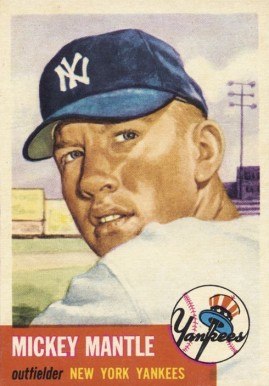 The 1953 Topps Mickey Mantle is one of the Mick’s most highly-coveted cards.
The 1953 Topps Mickey Mantle is one of the Mick’s most highly-coveted cards.
And many collectors would argue it’s his best-looking card of them all.
It’s an absolutely beautiful card…
This was Topps’ second year printing mainstream baseball cards and once again Mantle would be the most prized card in the set.
In this guide we’ll take a look at what makes this card so special and how you can determine how much they’re worth.
Let’s jump right in!
More...

Ross Uitts - Owner
Are you selling sports cards that were produced from 1868 - 1975?
If so, then please fill out the form below and I'll be in touch right away. Or, feel free to call/text me at 305-684-6680!
Front Design
Many collectors believe that the 1953 Topps is Mantle's best-looking card.
It's hard not to argue that point...the artwork is stunning.
A young Mantle is shown looking back over his left shoulder wearing his Yankee ball cap.

Usually collectors like to see a player in action on a given card either swinging a bat or throwing the ball.
But this card gets an easy pass.
Mantle's deep stare into the distance mixed with the color scheme of blues and reds give this card a classy look and feel.
Other quick facts:
- the card measures in at 2-5/8" by 3-3/4"
- this is card #82 out of 274 cards
- it was part of the first series in the set (cards #1 - 86)
- it was a short print (meaning fewer were printed, making it more rare and expensive)
Back Design
In my opinion, the design of the backs of the 1953 Topps set is one of the best they ever created.
It's got a bit of everything...even fielding stats, which you hardly ever see on cards.
The sections are broken out nicely: bio and personal info at the top, followed by a nice blurb about how promising Mantle was, and rounded out by stats and a nice trivia question at the bottom.

Personally, I like the way Topps presented Mantle's stats in a vertical layout.
It makes it easier to quickly read, in my opinion.
The facsimile autograph in red adds a nice touch, as well.
Overall, the design of the back of the card is simple, yet it packs a lot of detail.
Condition Issues
The two most common condition issues that you'll find with this card are:
- poor centering
- chipping of the red nameplate on the bottom border
Below you'll see an example that is suffering from both issues:

In order to achieve a top professional grade, the centering will have to be as close to 50/50 as possible.
But this one favors the right side of the card, so it will automatically decrease in grade and value.
Print standards were just not as tightly-controlled in the 1950's.
And while that red nameplate is one of the design elements that gives this card some nice pop, it's also prone to showing chipping and wear.
The tiniest nicks and dings will reveal the white paper stock beneath.
Value
So what are these cards worth?
How do you determine the value of a 1953 Topps Mickey Mantle?
The following prices are estimates from Professional Sports Authenticator (PSA) based on the condition of the card:

Graded on a 1 - 10 scale with 1 being the lowest and 10 the highest, the value can differ drastically as you can see.
In order to be graded in mint condition, the card has to be nearly perfect:
- centering has to be pretty much 50/50
- the corners have to be sharp with no signs of wear or rounding
- the surfaces can not have any blemishes, divots, cuts, creases or wrinkles
- the edges cannot be damaged or have any chipping
Most 1953 Topps Mantles that I see ungraded are in the 1 - 6 range.
Even as a 1 in poor condition, this card can be worth several hundred bucks.
But, the serious money comes into play once you start seeing conditions of 5 or above.
If you have one of these cards and you'd like me to take a look at it, please reach out to me using the contact form above.
Mickey Mantle's 1953 Season In Review
Mantle didn't put up monumental numbers in 1953 like we'd see later in his career but he still produced enough to make the All-Star team.
A quick look at his stats shows that he turned in quite a productive season at the plate:
- Games: 127
- At Bats: 461
- Runs: 105
- Hits: 136
- Home Runs: 21
- RBI: 92
- Batting Average: .295
- OPS: .895
The huge numbers of home runs and RBI weren't there, but he was already showing flashes of his brilliant play that would come.
He would also bat .208, collecting 5 hits, belting 2 home runs, producing 7 RBI and scoring 3 runs in helping the Yankees defeat the Brooklyn Dodgers in the 1953 World Series.
